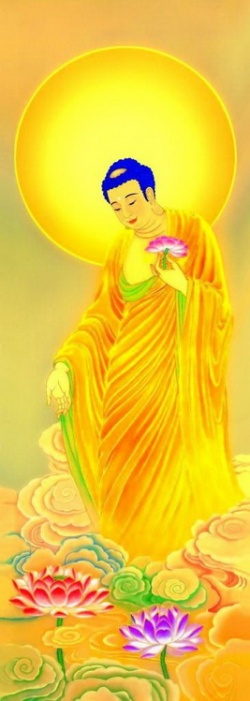Pure Land school
Pure Land school (1)
浄土門・浄土教・浄土宗 ( Jpn Jodo-mon, Jodo-kyo, or Jodo-shu)
Also, Pure Land (Chin Ching-t'u; Jpn Jodo) teachings. A general term for the Buddhist denominations of the Pure Land teachings in China and Japan. The Pure Land school teaches the attainment of rebirth in the Pure Land of Amida Buddha by means of devotion to Amida Buddha, especially, the recitation of Amida's name. The Buddha Infinite Life Sutra, the Meditation on the Buddha Infinite Life Sutra, and the Amida Sutra are known as the three Pure Land sutras.
(a) China: The Pai-lien-she (White Lotus Society), a religious group dedicated to Amida worship, was founded in 402 by Hui-yüan. This is said to have been the origin of Pure Land practices in China. In the early sixth century, T'an-luan received the Meditation on the Buddha Infinite Life Sutra from Bodhiruchi and thereafter propagated faith in Amida Buddha, asserting that one could be reborn in the Pure Land through Amida's grace. During the seventh century, T'an-luan's teaching was systematized by Tao-ch'o and his disciple Shan-tao.
(b) Japan: The Pure Land teachings including the Nembutsu, or meditation on Amida Buddha, were first adopted by the Tendai school when in 848 Jikaku, who was later the third chief priest of Enryaku-ji, the school's head temple, established a hall for constant active meditation (a form of walking meditation) on Mount Hiei and there practiced meditation on Amida Buddha. Ryogen (912-985), the eighteenth chief priest of Enryaku-ji, was probably the first to try systematizing the Pure Land doctrines. His disciple Genshin wrote The Essentials of Rebirth in the Pure Land, in which he systematized the teachings of meditation on Amida Buddha within the framework of Tendai doctrines. Later Yokan (1033-1111) of the Three Treatises (Sanron) school practiced the recitation of Amida's name. Honen (1133-1212), who was inspired by the works of Shan-tao of China and the Tendai priest Genshin of Japan, established the Pure Land school. He wrote The Nembutsu Chosen above All, in which he defined the sole cause of rebirth in the Pure Land to be the practice of calling upon the name of Amida Buddha. After his death, the school split into five schools: Chinzei, Seizan, Choraku-ji, Kuhon-ji, and a group centering around Honen's disciple Kosai. In addition to these schools, Shinran (1173-1262), who was a disciple of Honen, founded the True Pure Land ( Jodo Shin) school. Ippen (1239-1289), who studied under Shotatsu, Honen's second-generation disciple, founded a school of the Pure Land teachings known as the Time ( Ji) school. Besides these schools, there exists the Interfusing Nembutsu (YuzuNembutsu) school founded on the teachings of Ryonin (1073-1132), which saw a revival during the Edo period (1600-1867). In Japan, the Pure Land school is also known as the Nembutsu school. "Nembutsu" refers to the invocation of Amida's name—the words Namu Amida Butsu ("Homage to Amida Buddha")— chanted by the school's adherents.
(2)[浄土宗]( Jpn Jodo-shu): The Japanese Buddhist school established by Honen (1133-1212). Its head temple is Chion-in in Kyoto. The school's principal doctrine is that its followers revere Amida Buddha, believe in his original vow, and invoke Amida Buddha's name in order to be reborn in his Pure Land. In 1198 Honen wrote The Nembutsu Cho-sen above All, in which he defined the sole cause for attaining rebirth in Amida Buddha's Pure Land to be the practice of invoking that Buddha's name. Honen revered the patriarchs of the Chinese Pure Land school— T'an-luan, Tao-ch'o, and Shan-tao—and followed their example in dividing Shakyamuni Buddha's teachings into two categories, the Pure Land teachings (the three Pure Land sutras—the Buddha Infinite Life, Meditation on the Buddha Infinite Life, and Amida sutras) and the Sacred Way teachings (all other sutras). The Pure Land teachings are defined as the easy-to-practice way, or salvation through Amida's power, and the Sacred Way teachings as the difficult-to-practice way, or attaining enlightenment through personal power. The Pure Land school holds that the easy-to-practice way is the one way appropriate for the people of the Latter Day of the Law who are inferior in their capacity to understand Buddhism. Again, the practice of the Pure Land teachings is regarded as the correct practice, and that of the other teachings as sundry practices. Honen identified as the principal texts of his school the above three sutras and The Treatise on the Pure Land (also known as The Treatise on Rebirth in the Pure Land ) by Vasubandhu. Honen's teaching quickly spread throughout Japan, but was banned in 1207 when the influential Enryaku-ji temple on Mount Hiei and Kofuku-ji temple in Nara protested strongly, and Honen was exiled to Tosa. His disciple, Shinran, later established the True Pure Land ( Jodo Shin) school.
